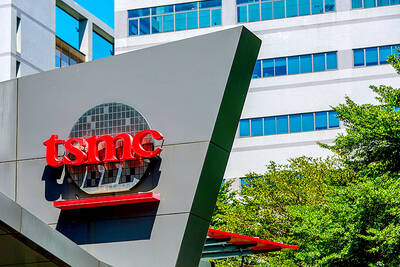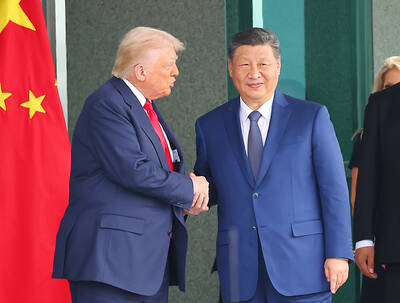A consensus was reached at the National Energy Conference yesterday to allow energy prices to revert back to the global market mechanism and reflect true purchase costs.
The agreement is expected to raise domestic energy prices and is intended to encourage the public, companies and the government to focus on alternative sources of energy, carbon dioxide emission cuts and energy conservation.
With electricity, oil and natural gas markets can focus on operating profitability rather than selling energy below cost at the request of government, forcing them to absorb substantial losses.
The energy conference also encouraged energy companies to focus on restricting carbon dioxide emissions through the use of energy processing technologies on purchased energy and to pass on the extra costs to consumers.
President Ma Ying-jeou (馬英九) on Wednesday said legislators should merge eight versions of a bill on renewable energy as soon as possible and pass the negotiated version by the end of this session.
CRITICS
However, opposition flared as nuclear power took center stage at the conference.
Environmental groups accused the government of manipulating the conference to promote nuclear power rather than actually encourage environmental sustainability.
Lee Ken-cheng (李根政), founder of Mercy on the Earth (地球公民協會), told reporters yesterday that the conference was used to endorse nuclear power as the only option to reduce carbon emissions, while dismissing every alternative.
“From 1990 through 2008, the nation’s carbon dioxide emission increased 130 percent, with three National Energy Conferences held during that period. What impact did these conferences have?” Lee asked.
Although 200 members from different environmental groups were allowed to attend, they were not allowed to speak, while people living close to nuclear plants were not allowed in, Lee said.
Only 5 percent of the energy generated by nuclear plants is transformed into power, while the rest becomes waste material, Lee Yuan-tseh (李遠哲), Nobel laureate and former president of Academia Sinica, said yesterday.
Taiwan only produces 1 percent of its energy, while the rest is imported from various countries. Developing domestic means to generate alternative energy is of utter importance, Lee said.
Homemakers Union and Foundation (主婦聯盟環境保護基金會) president Chen Man-li (陳曼麗) accused the government of lacking resolve in creating a low carbon society.
Nuclear power is an existing option to help Taiwan cut carbon emissions because the country has three atomic stations in operations, Premier Liu Chao-shiuan (劉兆玄) said at the end of the conference.
ADDITIONAL REPORTING BY BLOOMBERG

RUN IT BACK: A succesful first project working with hyperscalers to design chips encouraged MediaTek to start a second project, aiming to hit stride in 2028 MediaTek Inc (聯發科), the world’s biggest smartphone chip supplier, yesterday said it is engaging a second hyperscaler to help design artificial intelligence (AI) accelerators used in data centers following a similar project expected to generate revenue streams soon. The first AI accelerator project is to bring in US$1 billion revenue next year and several billion US dollars more in 2027, MediaTek chief executive officer Rick Tsai (蔡力行) told a virtual investor conference yesterday. The second AI accelerator project is expected to contribute to revenue beginning in 2028, Tsai said. MediaTek yesterday raised its revenue forecast for the global AI accelerator used

Taiwan Semiconductor Manufacturing Co (TSMC, 台積電) has secured three construction permits for its plan to build a state-of-the-art A14 wafer fab in Taichung, and is likely to start construction soon, the Central Taiwan Science Park Bureau said yesterday. Speaking with CNA, Wang Chun-chieh (王俊傑), deputy director general of the science park bureau, said the world’s largest contract chipmaker has received three construction permits — one to build a fab to roll out sophisticated chips, another to build a central utility plant to provide water and electricity for the facility and the other to build three office buildings. With the three permits, TSMC

TEMPORARY TRUCE: China has made concessions to ease rare earth trade controls, among others, while Washington holds fire on a 100% tariff on all Chinese goods China is effectively suspending implementation of additional export controls on rare earth metals and terminating investigations targeting US companies in the semiconductor supply chain, the White House announced. The White House on Saturday issued a fact sheet outlining some details of the trade pact agreed to earlier in the week by US President Donald Trump and Chinese President Xi Jinping (習近平) that aimed to ease tensions between the world’s two largest economies. Under the deal, China is to issue general licenses valid for exports of rare earths, gallium, germanium, antimony and graphite “for the benefit of US end users and their suppliers

Dutch chipmaker Nexperia BV’s China unit yesterday said that it had established sufficient inventories of finished goods and works-in-progress, and that its supply chain remained secure and stable after its parent halted wafer supplies. The Dutch company suspended supplies of wafers to its Chinese assembly plant a week ago, calling it “a direct consequence of the local management’s recent failure to comply with the agreed contractual payment terms,” Reuters reported on Friday last week. Its China unit called Nexperia’s suspension “unilateral” and “extremely irresponsible,” adding that the Dutch parent’s claim about contractual payment was “misleading and highly deceptive,” according to a statement